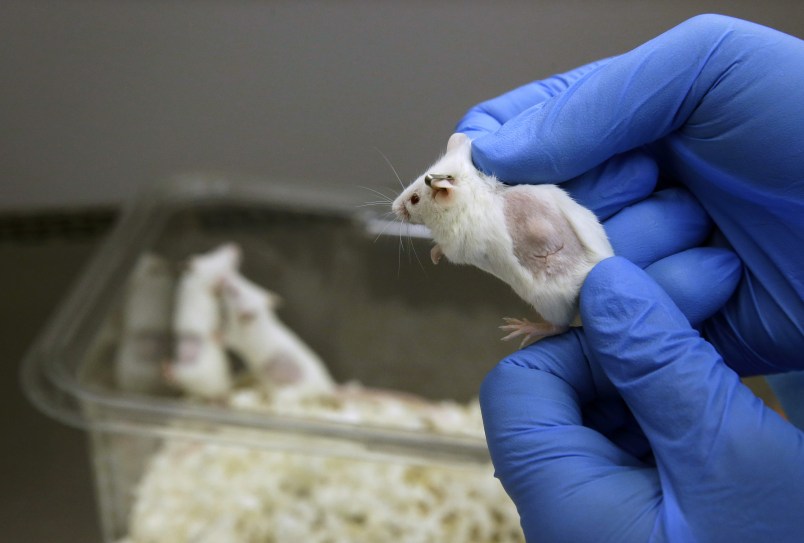Scientists often test drugs in mice. Now some cancer patients are doing the same — with the hope of curing their own disease.
They are paying a private lab to breed mice that carry bits of their own tumors so treatments can be tried first on the customized rodents. The idea is to see which drugs might work best on a specific person’s specific cancer.
The mice may help patients make what can be very hard choices under difficult circumstances. Studies can suggest a certain chemotherapy may help, but patients wonder whether it will work for them. Often there’s more than one choice, and if the first one fails, a patient may be too sick to try another. So hundreds of people have made “mouse avatars” over the last few years to test chemotherapies.
“What I’m doing is personalized cancer treatment. It’s the wave of the future,” said Eileen Youtie, a Miami woman using mice to guide care for her hard-to-treat form of breast cancer. “Part of this is trying to eliminate chemos that are not going to work on me. I don’t want to waste time taking them and poison my body.”
But there are no guarantees the mice will help.
“There’s not a lot of science” to say how well this works, and it should be considered highly experimental, said Dr. Len Lichtenfeld, deputy chief medical officer of the American Cancer Society.
There are some early encouraging reports, he said. One study of 70 patients found the mice generally reflected how well patients responded to various drugs. But there is no evidence that using mice is any better than care based on medical guidelines or the gene tests that many patients get now to help pick drugs.
Mouse testing costs $10,000 or more, and insurers don’t cover it. It takes several months, so patients usually have to start therapy before mouse results are in.
“I do see promise, but it’s very time-consuming, it’s very expensive. For the average patient, standard care is going to be the way to go,” said Alana Welm, a cancer researcher at the Oklahoma Medical Research Foundation. She gave a talk on mouse avatars last week at the San Antonio Breast Cancer Symposium. It was the third major cancer meeting this year to feature work on customized cancer mice.
Several labs breed these mice but the main supplier to patients has been Champions Oncology, a company based in Hackensack, New Jersey, that also operates in London, Tel Aviv and Singapore. About 7,000 mice are kept in a Baltimore lab with six rooms that resemble stock rooms of a shoe store, with tall shelves that hold row upon row of plastic cages labeled with each cancer patient’s name.
Most mice are white-haired females with beady red eyes, but others are hairless. Some live alone while others climb over one another and sleep in small piles. All have easy access to food and water, and many bear signs of the tumor graft — a shaved portion of hair, an incision scar and a lump growing off one side.
Patients have a tumor sample sent to Champions, which charges $1,500 to bank it, plus $2,500 for each drug tested in groups of mice implanted with bits of the tumor. Most patients try three to five drugs and spend $10,000 to $12,000, said Champions’ chief medical officer, Dr. Angela Davies.
Youtie spent $30,000 “because I want them to test all the possible drugs,” even some for other types of cancer.
That approach helped Yaron Panov, a 59-year-old Toronto man diagnosed four years ago with liposarcoma, a soft-tissue cancer. No specific drugs were recommended, and “I was given six months to live,” he said.
Tests on his avatar mice suggested the first drug he was prescribed would not work but that one for colon cancer might.
“It was working on the mice so I knew it would work on me,” he said. “It’s such a boost of confidence” and it makes it easier to endure side effects, said Panov, whose cancer is in remission.
Reuven Moser, a 71-year-old man from Tel Aviv, Israel, said his avatar mice confirmed that drugs prescribed for colon cancer that had spread to his liver were a good option.
“Most of the time the oncologists want to follow a protocol, but they don’t know how it will affect the patient,” Moser said. “It was very reassuring” to see the mice respond, he said. Moser’s mice were bred in February and he is still undergoing treatment.
Dr. Andrew Gaya of Leaders in Oncology Care, a private clinic in London, helped lead the 70-patient study of avatar mice and gave results at a cancer conference in September. It looked back at how well mice performed in patients whose outcomes from treatment were already known. About 70 percent of the time, tests in the mice suggested something that turned out to have helped the patients, he said. And if something had not worked in the mice it almost never worked in a patient.
Mice have some drawbacks, said Dr. Benjamin Neel, director of research at Princess Margaret Cancer Centre in Toronto and a spokesman for the American Association for Cancer Research.
The tumor grafts are under the mouse skin — not in places where the cancer normally occurs, such as the pancreas or lungs, and therefore don’t reflect the human tumor’s environment. The mice also have highly impaired immune systems so they can tolerate the human tumors. That means they don’t reflect how a person’s immune system would respond to a treatment and cannot be used to test immunotherapies.
“Even if it turns out these have real value,” they’re likely to be eclipsed by newer advances, such as ways to grow tumor cells in a lab dish that take only a few weeks, he said.
For now, mice seem the best bet, along with gene testing and her doctors’ advice, said Youtie, the Miami woman with breast cancer. Her mouse testing suggested that either of two drugs would be effective, so she chose the one thought to have fewer side effects on the heart. She recently finished chemotherapy, is about to finish radiation treatment, and said she does not feel guilty about using the mice.
“Animal abuse? I don’t look at it that way,” she said. “It’s not testing cosmetics. It’s trying to save my life.”
___
Associated Press videographer Cindy Sharp contributed reporting from Baltimore.
___
Marilynn Marchione can be followed at http://twitter.com/MMarchioneAP
Copyright 2014 The Associated Press. All rights reserved. This material may not be published, broadcast, rewritten or redistributed.








